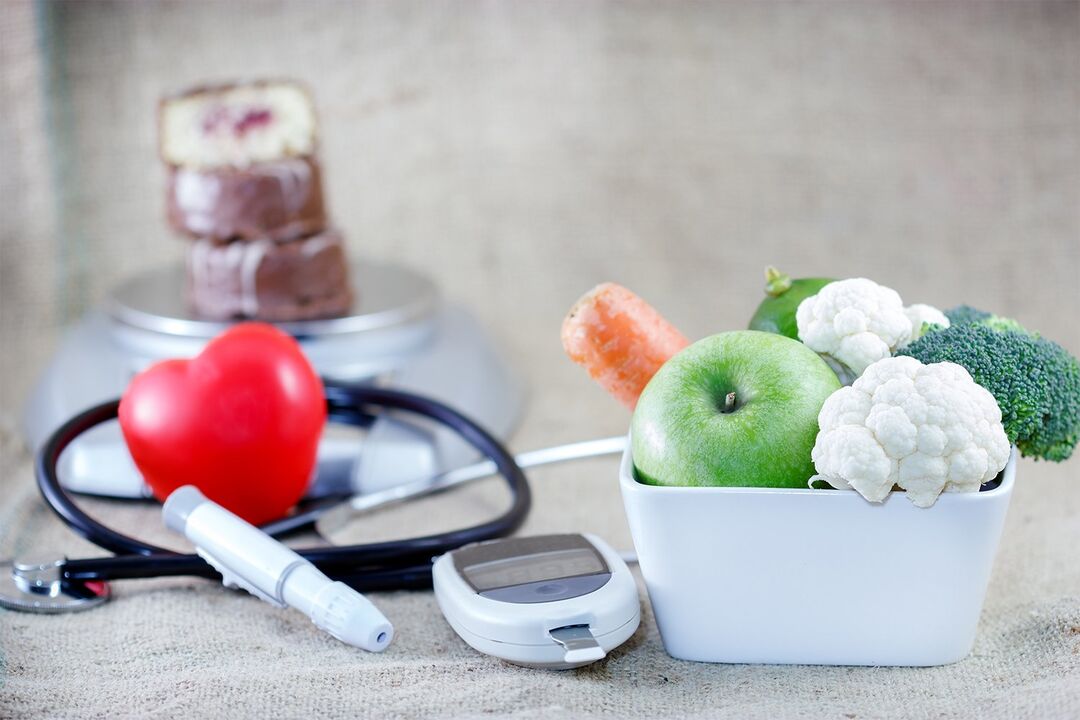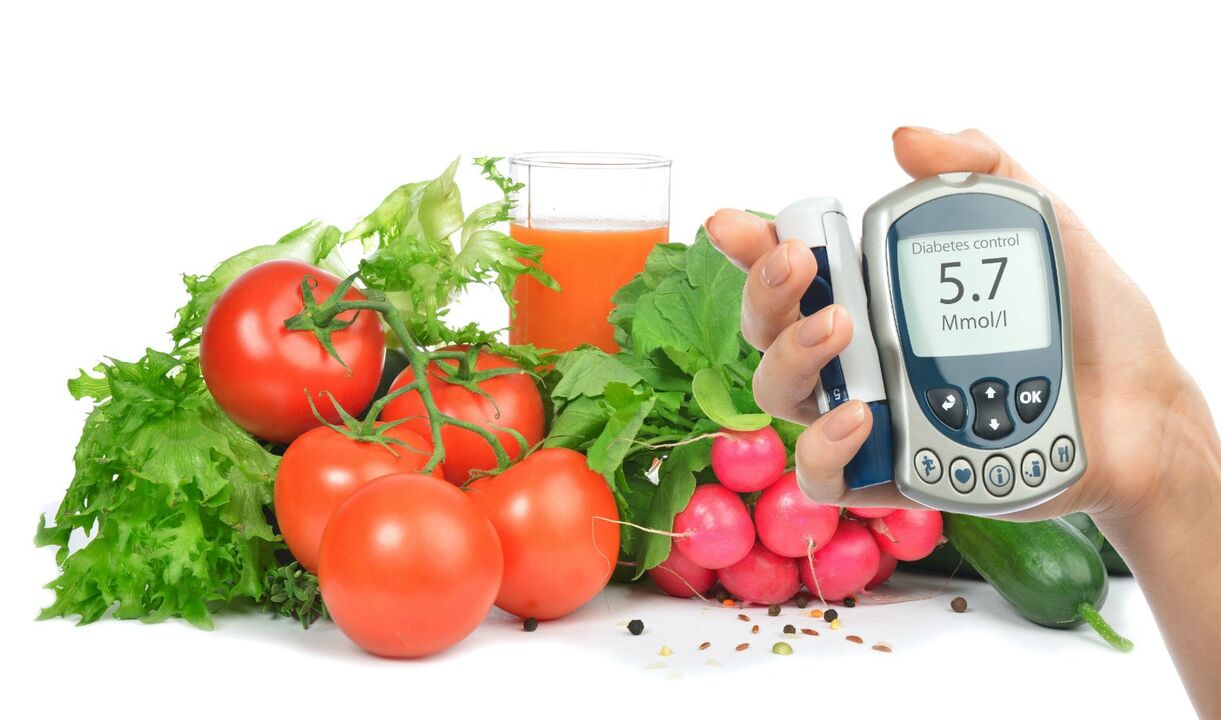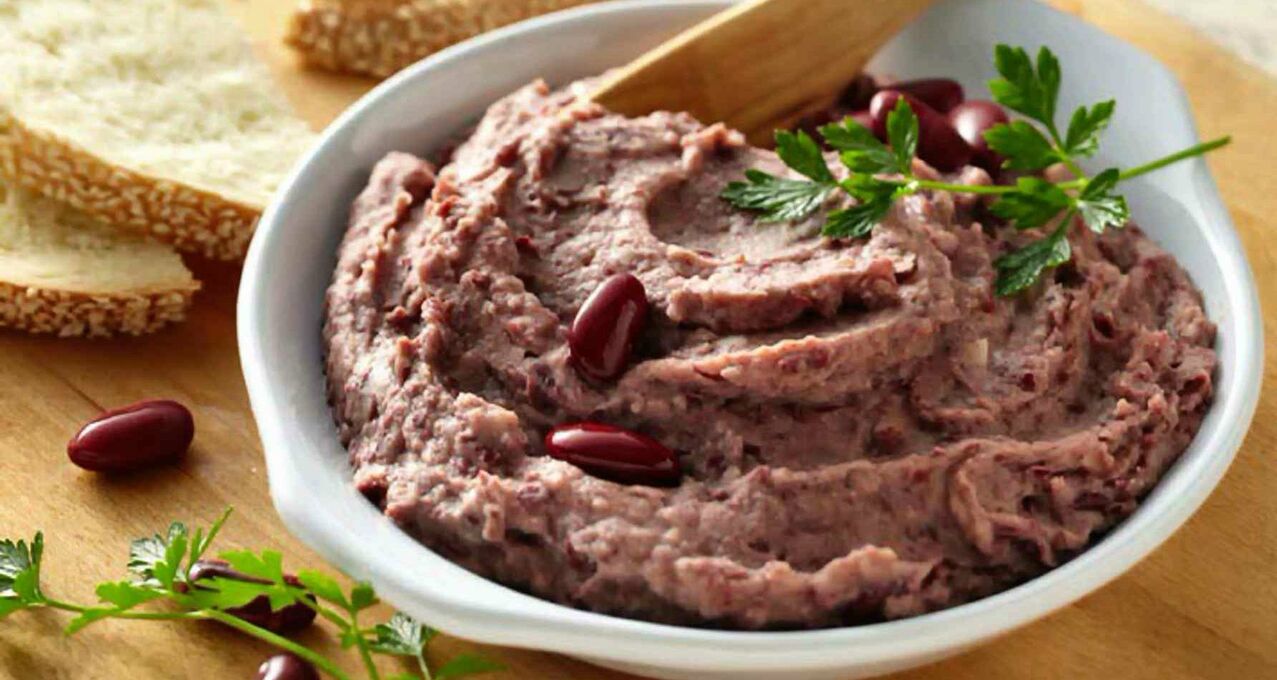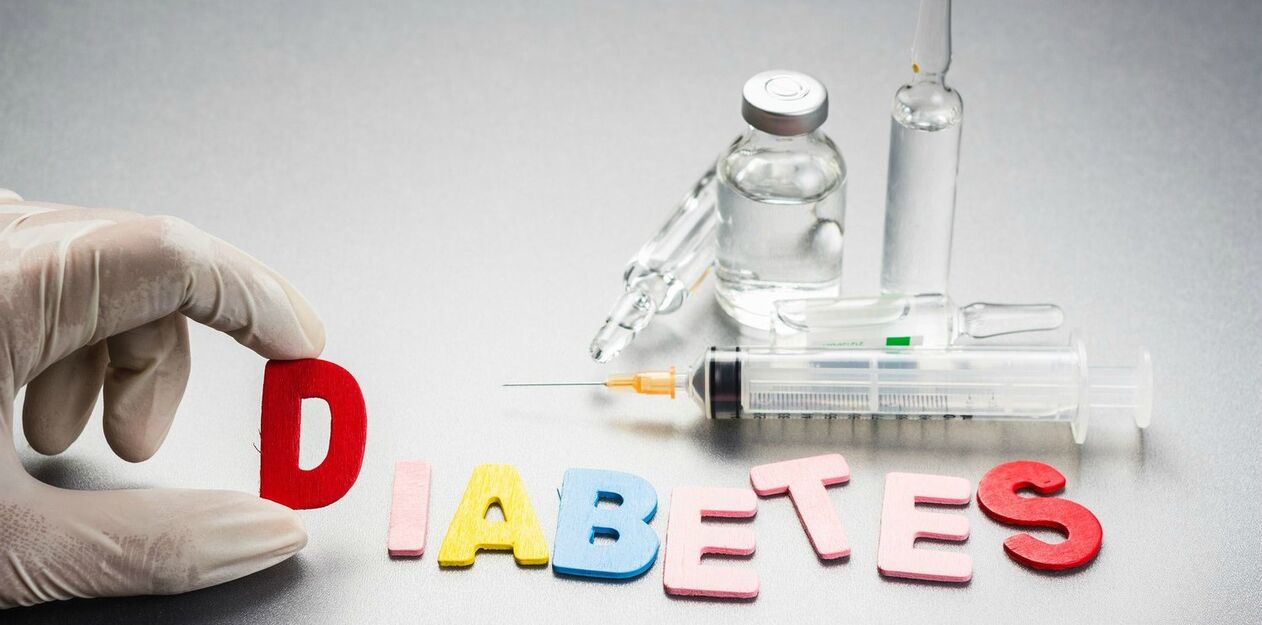Diabetes mellitus is a disorder of carbohydrate metabolism. Its essence lies in the fact that the body cannot properly absorb glucose. The disease is divided into two types.
In type 1 diabetes, abnormal cells in the pancreas do not produce enough insulin to keep blood sugar levels stable.
Type 2 diabetes accounts for about 90% of all diagnosed cases of the disease. It occurs when the insulin produced is not perceived by the body, ie. there is resistance to it.

Dietary guidelines for diabetes.
The fundamental principle of the diabetes diet is not to reduce the amount of any type of food, but to correctly reconstruct the entire diet and maintain it for the rest of your life.
From the point of view of biology, food is a source of vital vitamins, trace elements and necessary energy.
With diagnosed diabetes, they seek to reduce the amount of this energy a person receives from food. Its excessive amount is the cause of excess weight, which only worsens the course of the disease.
The main components of the diet for diabetes are fats, proteins and carbohydrates. Carbohydrates are the main source of energy used by the body. Their share is about 50% of the daily intake of food consumed.
There are three groups of carbohydrates:
- The ones that don't need to be counted. They are foods enriched with vegetable fiber (with the exception of legumes and potatoes due to their high starch content).
- Slow digestion carbohydrates (cereals, fruits, vegetables).
- Fast digestible carbohydrates (sweets of all kinds).
To calculate the insulin dose, the amount of carbohydrates consumed is taken into account according to the "bread units" system. One unit of bread (XE) is equivalent to 10-12 g of carbohydrates. Comprehensive tables have been created to help accurately determine its approximate content in a particular type of food.
The required number of bread units is determined by the person's weight and the degree of his physical activity. Approximately this number is equal to - 15-30 XE per day.
Using the XE table, adjusting blood glucose levels before and after meals, you can calculate the required dose of insulin, which controls sugar levels and the process of carbohydrate metabolism itself. If tabular data are not available, the "hand and plate rule" applies, where the size of the products consumed is determined by the size of the hand and the plate.
Another indicator that plays an important role in organizing diabetic nutrition is the glycemic index (GI). Helps control carbohydrate metabolism and determines the most favorable nutritional choice. It was first introduced by the Canadian specialist A. Jenkinson in the early 80s of the 20th century.
The GI of glucose itself is 100 units. The sooner your level rises after eating food, the higher the rate. GI - an indicator of the degree of usefulness of the product. Its low value indicates that the product is recommended for people with diabetes. A high GI value indicates useless calories. Low GI foods slowly raise blood glucose levels. And with a high, on the contrary, it quickly increases blood glucose. The first group includes vegetables, fresh fruits, wholemeal bread, seafood, eggs, etc. The second group includes rolls, candy, soft drinks, packaged juices, etc. Knowledge of the main criteria for a diabetic diet allows you to regulate the course of the disease, improve the quality of life of such patients.
Characteristics of the diet for diabetes.

Patient studies have shown that strict adherence to an approved diet and nutritional patterns are essential for the successful treatment of diabetes mellitus, minimizing potential complications and maintaining good health.
For people with diabetes, it is necessary to observe a number of features that regulate the diet, regardless of the severity of the disease and treatment methods.
A person should be aware that no matter what treatment is chosen for him, the success of it will primarily depend on the culture of nutrition.
The nutrition scheme is selected for each patient individually, based on weight, age and the degree of daily physical activity.
The goal of the diabetic diet is to control glucose levels and keep them at an optimal level, according to generally accepted standards. It is important that the diet is balanced and enriched with a series of vitamins and minerals. He is obliged to ensure the supply of the necessary energy so that the patient's body weight is close to the ideal indicators and remains stable for a long time. The diet must comply with the principles of rational nutrition.
diet for type 1 diabetes

Experts in the field of nutrition are unanimous in their opinion that the diet plan for type 1 diabetes should be balanced and based on the postulates of proper nutrition, as well as for those who do not suffer from this disease. Since there is no ideal diet for diabetics, these patients must pay close attention to the ratio of carbohydrates, fats and proteins that enter the body. This will help you adjust your diet. A diabetic diet does not mean the total exclusion of certain foods, but you should consider how one or another product affects blood glucose.
Recommendations for the amount of food consumed look like this:
- reduce the amount of juices and packaged drinks that increase glucose levels. The consumption of low-sugar beverages and special dietary liquids is recommended;
- You cannot completely eliminate carbohydrates from your diet. Its absence, in combination with insulin treatment, can significantly reduce sugar levels, which will negatively affect overall health;
- eat as many low GI vegetables as possible;
- reduce the amount of fast food and fast food consumed.
A large proportion of patients diagnosed with type 1 diabetes report the effectiveness of a low GI diet. This helps prevent sudden blood sugar fluctuations after a meal.
When planning, an important aspect is the calculation of the amount of carbohydrates. Pay special attention to diabetics who approach their diet responsibly. With the correct calculations, you can find out exactly what dosage insulin should have, as well as get relief when choosing the desired products.
Another popular method of insulin therapy is the basal bolus.
It consists of taking a bolus immediately before a meal to regulate the optimal level of glucose within acceptable limits. Such a diet provides greater flexibility when choosing a diet, allows you to independently adjust the required dose of insulin, depending on the amount of carbohydrates consumed.
diet for type 2 diabetes

The main requirement is compliance with a healthy diet aimed at reducing body weight. Excess weight has a significant impact on the course of the disease and the development of insulin dependence. In order for the fight against excess weight to be successful, you must follow all the recommendations.
The diet for type 2 diabetes has three fundamental principles:
- The use of vegetables.Their number is determined by the age, sex and physical activity of the patient. Women who exercise for 30 minutes should include about 500 g of this type of product in their diet. If the sports are more intense, the amount of vegetables increases to 800 g, so men should consume 600 and 1000 g.
- Unsaturated fats.Its presence in the shopping basket helps regulate cholesterol levels and minimizes the probability of developing diseases of the cardiovascular system, which are integral companions of diabetes. Such fats are found in nuts, mackerel, tuna, avocado, olive oil, etc.
- Exclusion of processed foods.Their refusal favorably affects the health of diabetics, which has been repeatedly confirmed by doctors. As a rule, these foods can be stored for a long time thanks to special additives. It has a high GI. Its constant use negatively affects the general condition of the body of patients with diabetes.
As with type 1 diabetes, people with type 2 are advised to follow a low carbohydrate diet and include low GI foods in their diet. This will help reduce blood glucose spikes. To determine how well the diet is composed, it is necessary to constantly monitor the numerical value of sugar before and after meals. The data obtained will show how the body responds to the selected diet. If the efforts made do not give positive results, it is worth considering the introduction of special antidiabetic drugs.
People with type 2 diabetes should also not skip the basal bolus diet. It will keep your glucose levels at an optimal level and improve overall health.
Foods allowed and prohibited in a diabetic diet

Carbohydrates are one of the main sources of fat. People with diabetes should use them with caution, but completely excluding them from the diet is not recommended, since all food components are important for the normal functioning of human organ systems. Nutritionists advise reducing the amount of fast carbohydrates and increasing the amount of slow ones.
Fast carbohydrates are found in foods such as:
- cakes and sweets;
- pasta;
- dad;
- Fast food;
- starch.
Vegetables and other plant-based foods are rich in slow foods. It is she who will improve health.
The diet menu for diabetes should include:
- various types of cabbage (Brussels white broccoli);
- seaweed;
- Tomatoes;
- green and onion;
- green beans;
- fungus;
- cucumbers and celery;
- eggplant etc.
Garlic, beets, nuts, fish, avocados, etc. They will help lower blood glucose levels. The list of foods allowed in the diet is quite extensive. They are characterized by a low GI, high content of healthy fiber, which helps reduce the risk of glycemia. Thanks to its action, glucose enters the blood in minimal quantities, and the presence of a large number of vitamins and trace elements will help normalize the work of all vital systems of the body.
The list of prohibited foods in a diabetic diet is as follows:
- any confectionery, white flour muffins;
- honey;
- various pickles and freshly made juices;
- condensed milk;
- canned products;
- syrups;
- fatty meats and fish;
- potatoes, rice;
- foods high in trans fats;
- semi-finished products.
sweeteners for diabetes

For people with diabetes, there is an alternative that allows you to replace common sugar with special supplements. They are divided into two categories: those that participate in the exchange processes and those that do not.
The most popular sweetener is fructose. It is produced by processing fruits. Unlike normal sugar, it is much sweeter and has a low GI. Its use does not lead to jumps in blood glucose levels. Natural substitutes also include sorbitol (found in apples, rowan berries, and other fruits), erythritol ("melon sugar"), stevia (obtained by processing a plant with the same name).
Industrial sweeteners include sucralose, aspartame, saccharin, cyclamate, etc. The market for these additives is mainly represented by products of artificial origin.
Contraindications for diabetes

The main contraindication for diabetes mellitus of any type is the strict restriction of carbohydrates consumed, which have an extremely negative effect on the level of glucose in human blood. It is forbidden to eat sweets, ice cream, drink drinks containing sugar. Under control is the use of bakery products, honey. If glucose levels are high, exercise should be limited. Under the ban are alcoholic and low-alcohol beverages, which also cause glycemia, which is fraught with fainting, increased sweating and weakness. Patients with problems with the organs of vision should refrain from visiting the bath and sauna. High temperatures cause small blood vessels to burst.
Diabetes is a serious disease that should not be taken lightly.
Diet for diabetes: menu of the week.

Various menus for diabetics have been developed. One of the most common diet options for diabetes is menu number 9.
The simplest diet for a week could look like this:
- Breakfast- an omelette with asparagus or buckwheat porridge, oatmeal on the water, black tea.
- Dinner- beans, beets, pickles, allowed vegetable stew, eggplant, raw carrot salad, apple.
- afternoon tea- rye bread, cottage cheese, kefir.
- Dinner- Stewed mushrooms, baked salmon fillet or boiled fish, stewed cabbage.
Less salt is recommended for cooked foods. Doctors advise keeping a special diary in which you need to write down everything that was eaten and in what quantity.
Recipes for a diet for diabetes.
The list of allowed products includes beans and cottage cheese. On the Internet you can find a huge number of recipes for a diet for diabetes, which will make the diet varied and interesting.
bean pate

Drain excess liquid from canned beans. Grind the product with a blender until a homogeneous consistency is obtained. Finely chop the onion and fry a little until transparent. Grind walnuts. Peel the pomegranate seeds. Mix the bean dough with the rest of the ingredients, salt. Delicious and healthy pâté ready to eat.
Cheesecakes with tomatoes

In a bowl, mix cottage cheese, egg, add oatmeal and spices. Rinse the tomatoes in boiling water, cut into slices. Stir the curd mass until smooth, shape the cheesecakes with wet hands and fry with the addition of olive oil in a frying pan. The dish is served with sour cream.
Diet for diabetes: reviews of nutritionists.

Nutritionists have extensive experience for many years in the treatment of diabetes of any type by introducing a strict diet. Despite similar treatment tactics, different diets have their own individual characteristics. Feedback from nutritionists is such that an individual nutrition plan for diabetes should be selected for each individual patient. In one opinion, doctors agree: successful treatment of diabetes is impossible without a correct and competent approach to diet.













































































